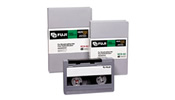3/4″ U-Matic Videocassette
U-matic is a videocassette format first shown by Sony in prototype in October 1969, and introduced to the market in September 1971. It was among the first video formats to contain the videotape inside a cassette, as opposed to the various open-reel formats of the time. Unlike most other cassette-based tape formats, the supply and take-up reels in the cassette worked in opposite directions during playback, fast-forward and rewind: one reel would run clockwise while the other would run counter-clockwise. A locking mechanism integral to each cassette secures the tape hubs during transportation to keep the tape wound tightly on the hubs. When the cassette is loaded into the videocassette recorder (VCR) or player, the mechanism releases the hubs, permitting the hubs to spin. A spring-loaded tape cover door protects the tape from damage; when the cassette is inserted into the VCR, the door is released and is opened, enabling the VCR mechanism to spool the tape around the spinning video drum. Accidental recording is prevented by the presence of a red plastic button fitted to a hole on the bottom surface of the tape; removal of the button disabled recording. As part of its development, in March 1970, Sony, Matsushita Electric Industrial Co. (Panasonic), Victor Co. of Japan (JVC), and five non-Japanese companies reached agreement on unified standards.
